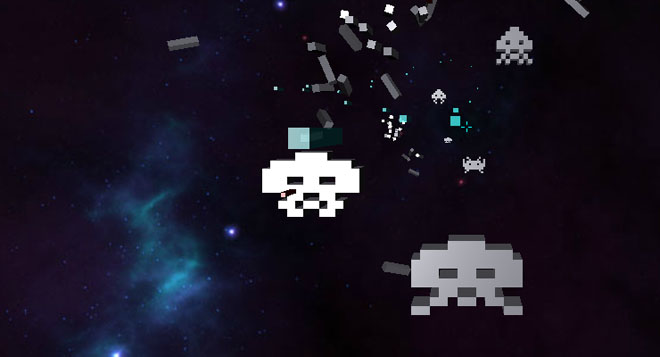Some of you may remember the bundled Away3D game that came with the first Adobe Gaming SDK download towards the end of last year. Called Invawayders (already regretting that title…), it demonstrated a simple Away3D interaction with pixelated 3D space invaders, and had compilation options for both mobile (phone/tablet) and web applications.
The game has recently had a bit of a spring clean, and in order to give it a more permenant home, we’ve uploaded to a new source repository in github. The source is arranged in three libraries, a core lib containing all shared assets and logic, and two FB projects for mobile and web publishing respectively. Instructions for installation can be found in the README.md file.
The game itself plays very similar to the existing Invawayders demo bundled in the Gaming SDK, however this version has a couple of significant updates to it’s code architecture:
- The game loop is now managed by the Ash framework, an extremely clean and flexible entity framework for AS3
- The required Away3D version is has been updated to 4.1 Alpha, taking advantage of some of the new particle APIs
The live versions of the game have also been updated, these can be found in the following locations for each respective platform:
- Google Play: https://play.google.com/store/apps/details?id=air.invawayders&hl=en
- Apple iTunes: https://itunes.apple.com/gb/app/invawayders/id566559602?mt=8
- Facebook: http://apps.facebook.com/invawayders
I am only just getting to grips with Facebook’s new App Center, so it may take a while for me to work out how to link the mobile games from the app page, but according to FB developers, the experience should be “seamless”. At least i finally worked out how to get that “play” button working again on the community page. Info about the game will appear here from now on now when there are any more updates etc, and if we’re really lucky we should be able to get the username shortcut for the page after 25 likes ![]()
Would be interested to hear what people thought of the re-architecture. I’m actually quite liking the approach that Ash places on game development, the conversion took a while to get my head around but after a bit of code wrestling, everything seemed to fall neatly into place. Hopefully I’ll be getting a chance to apply Ash to some more Gaming SDK examples in future.
